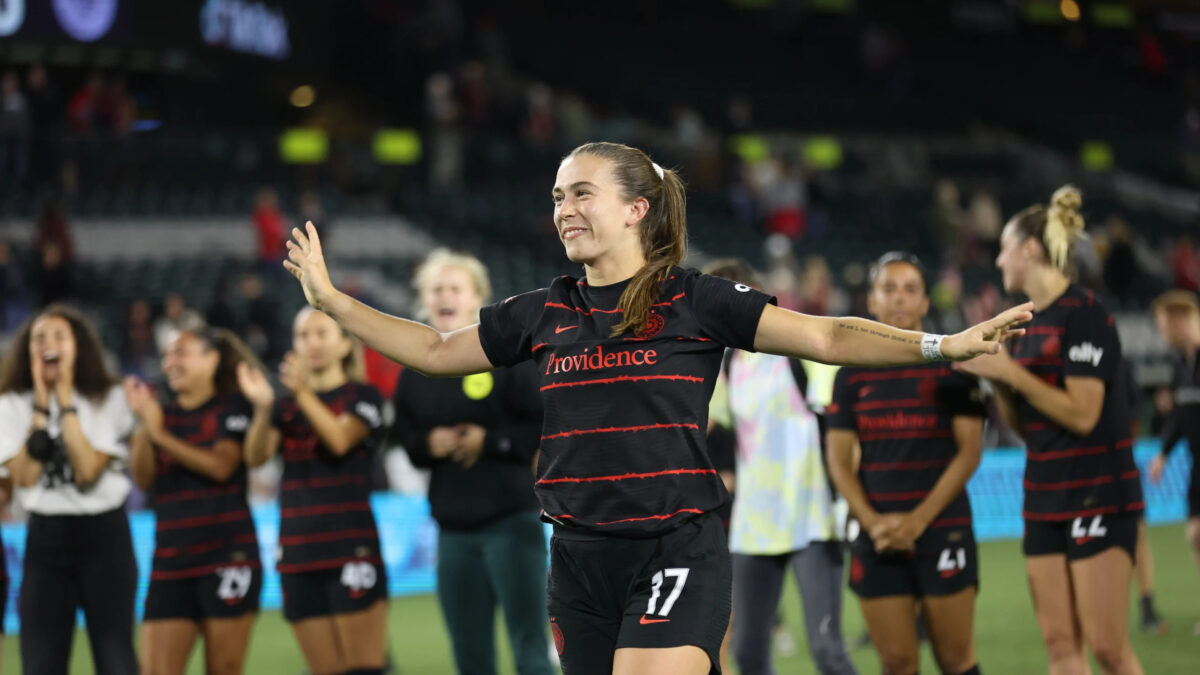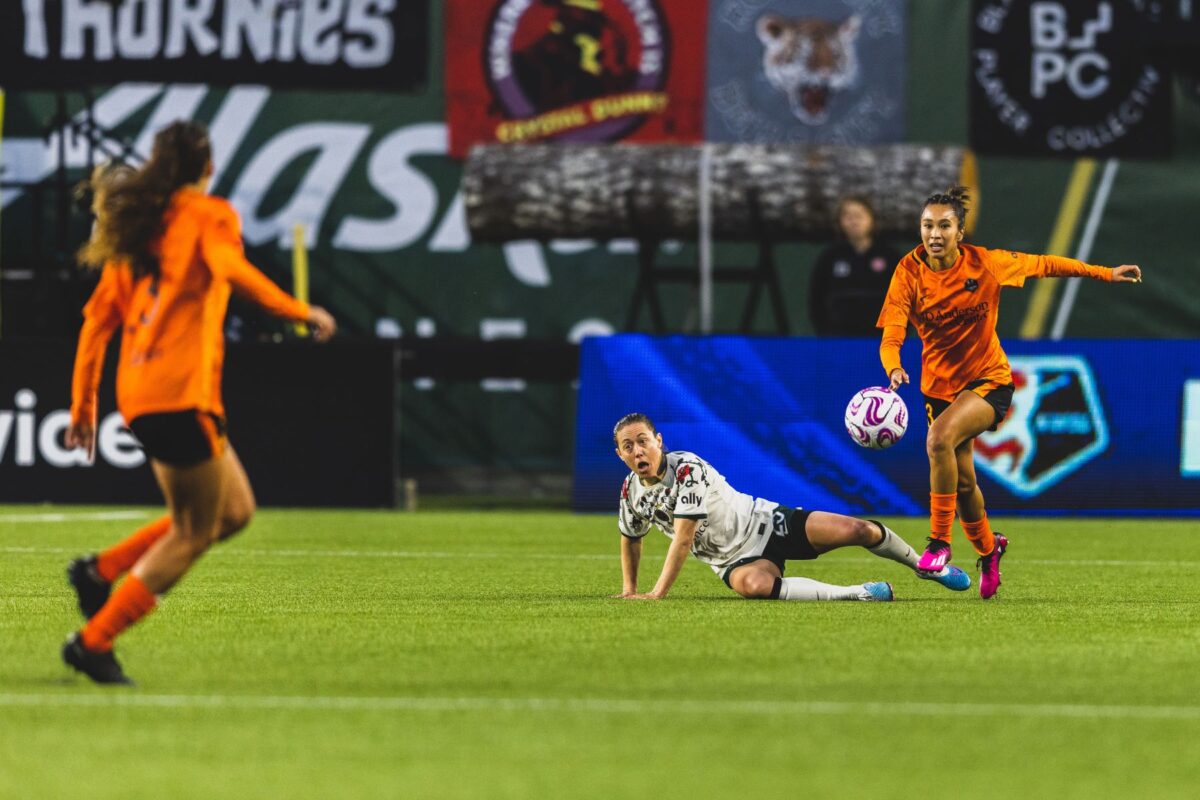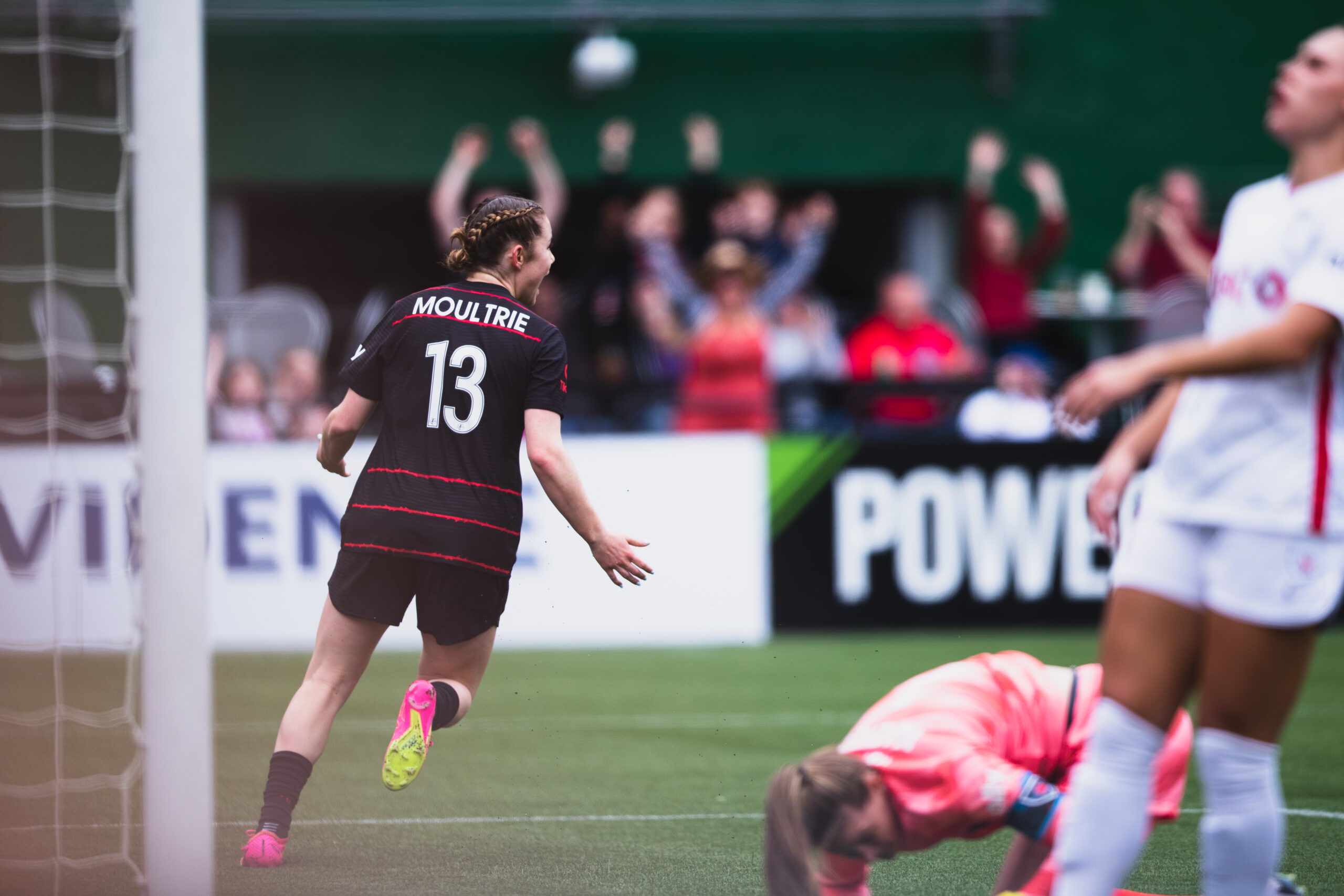To view this content, you must be a member of the Rose City Review Patreon
Already a qualifying Patreon member? Refresh to access this content.

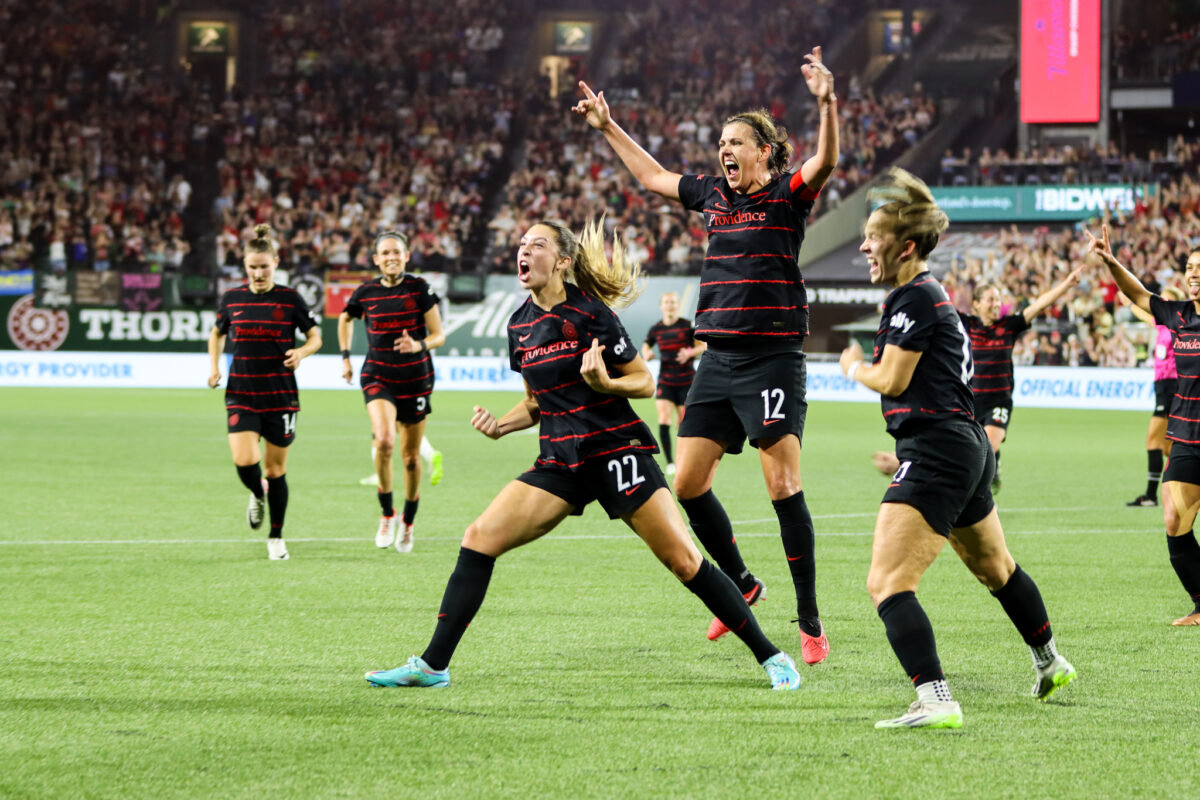
It felt as though the vintage Portland Thorns were back in action Saturday night, as they soundly defeated OL Reign in front of a sold-out Providence Park. It was the last time that the complete trio of Megan Rapinoe, Jess Fishlock, and Lu Barnes would face Christine Sinclair in Portland—which undoubtedly helped increase attendance numbers and added a sentimental tenor to the entire game. All four players reassured the crowd that during those 90 minutes the teams were fighting for more than just three points in a tight end of season table; they were fighting for the pride of their cities.
It was the first time since the inaugural 2013 season that Portland managed to take both home and away wins against Seattle in the regular season, and their first home win of the rivalry since 2018. Hopefully, such a solid beating of a longtime and fierce rival will propel the Thorns to end the season, helping them pick up their first three consecutive wins since 2019, as well.
Last week at a league-wide press conference, NWSL Commissioner Jessica Berman confirmed that the Thorns were on track to being sold by the end of the calendar year and that Merritt Paulson no longer sits on the Board of Governors. (Portland’s representative is currently Portland Timbers and Thorns CEO Heather Davis.) The process of the sale has taken far too long, but the confirmation that the team will in fact get a new owner (and hopefully new grass practice facility) makes me feel as though the Thorns can start to redefine themselves and their relationship to the city after a few dark years.
I find it hard to grasp the simultaneous nature of beginnings and endings, and this game represented both. The Thorns that I grew up with from 2013 through 2019 were different from the Thorns post-2020. Of course, the coaching and personnel changes are part of the natural course of a professional team, but since 2020, it has felt as though there is a disconnect between the team and its fans, largely brought upon by poor leadership decisions that have directly perpetuated and covered up abuse. Being free from the shadows of Paulson will allow the team to get their spot in the sun that they deserve.
Saturday’s game was the last time that Rapinoe played in Providence Park. Even though she is one of the Thorns’ biggest villains, it seems remiss to not talk about her. Of course, a rivalry game is about more than one player (and we will still have to deal with Fishlock next year…), but Pinoe seems to embody what it means to really love what you do and who you play for.
“We’re definitely two different types of people,” Sinclair said of Rapinoe postgame. “But what she’s done for the game, I think she’s helped inspire an entire generation of young soccer fans. And I fully support anyone that wants to grow women’s football, women’s sports. I’m gonna miss playing against her. This rivalry is gonna miss having her. I think our fans are gonna miss booing her.”
Pinoe has always made soccer fun. Even when I’m watching the USWNT play the most mediocre Vlatko-ball I’ve ever seen in the middle of the night, I know that as soon as Pinoe subs on she will liven things up and add flair and fun. I think that element of fun is something that has been missing from the Thorns’ culture for the past few years. The Thorns love emphasizing their mentality of winning and success, but sometimes I’m afraid that they’ve lost sight of the love of the game.
But then I see Pinoe hamming it up to the North End after scoring a goal or Morgan Weaver pretending to be one of those inflatable car-sale balloons, and I realize that these players do still have fun. Going forward, I want to see more of that: fun celebrations and laughing on the pitch and putting on a show. I want to thank Pinoe and the OGs for always having fun on the pitch, because it makes me have a lot more fun watching.
I also know how hard it is to remember why you are doing something when people, in particular your employers, are cruel or unhelpful. I sincerely hope that the sale of the team and dissociation from Paulson will fill the North End again and start selling out Providence Park. Even at 3:30 a.m. from my bed in Dublin, Ireland, I could see the influence that the city can have on a game.
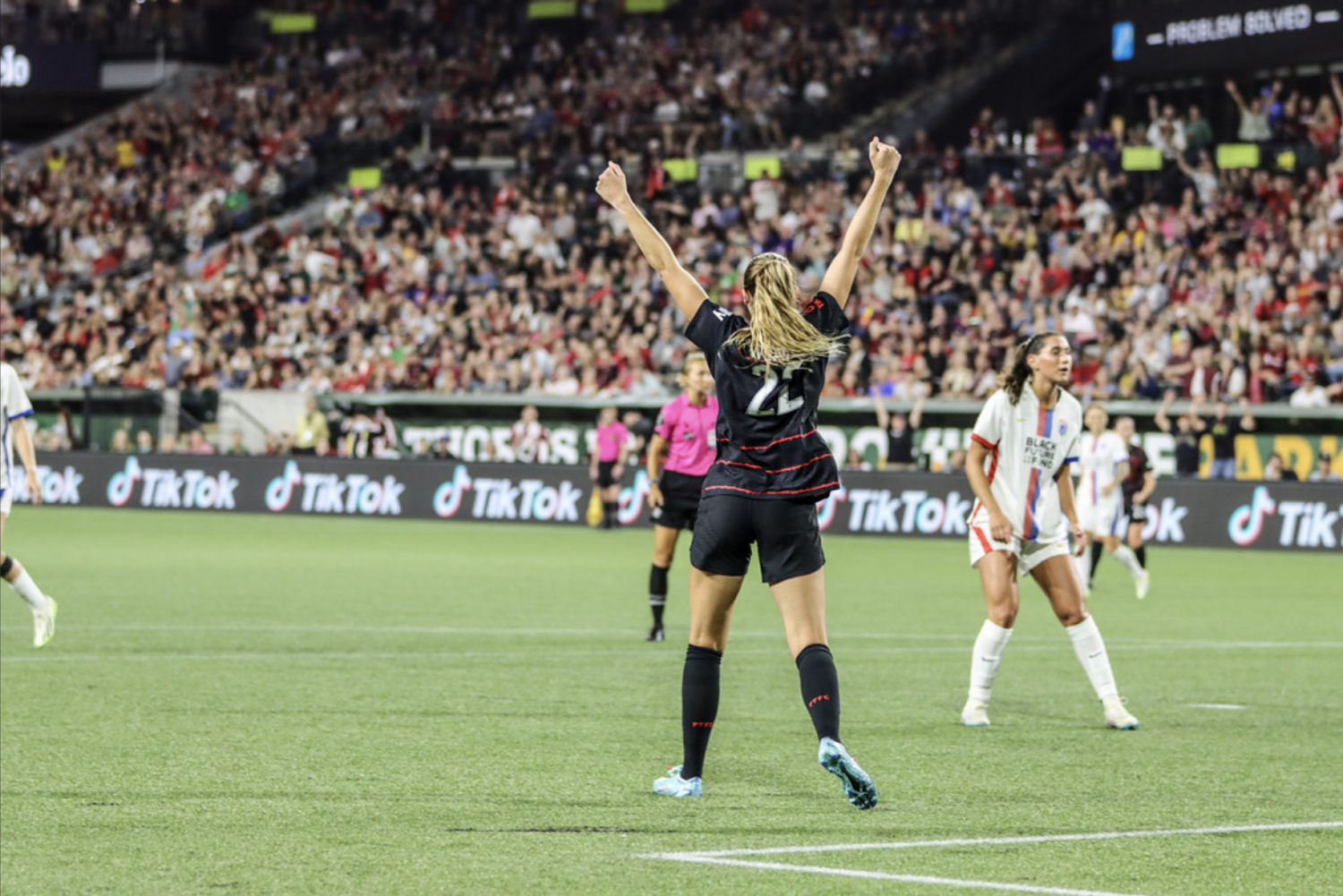
With every ending comes a new beginning. Morgan Weaver came alive as the new embodiment of the “F— Seattle” sentiment that is so necessary for a good rivalry. In a weird parallel with Pinoe, Weaver grew up in Washington but now plays for the rival state. Postgame, when asked about her celebration where she pointed enthusiastically at the Thorns badge on her jersey, she said, “I’m from Tacoma, but I’m just gonna show them where I love, and I love Portland, and I love being here and I love being on this team. So, I just had to let them know Portland’s where it’s at.”
Weaver has really come to life on the field this year. Her past seasons in Portland have by no means been lackluster—she has probably scored the most clutch game-winning goals for the team since she landed with the club in 2020—but she often falls into Sophia Smith’s shadow, being drafted second to her and playing alongside her. On Saturday, Weaver scored her 10th goal in all competitions this season off an incredibly well-struck volley straight back across goal. Her confidence in front of goal has skyrocketed, and it has made her a much more complete striker.
But what makes Weaver such a dangerous player is her dynamism. She had seven recoveries, the fourth most on the team, and also had the most shots on the team at four. Her involvement at both ends of the pitch is part of her core identity as a player. The fact that Weaver has been able to sustain this level of play throughout the season (she has played the third most minutes on the team) while consistently improving her awareness and skill shows how high her ceiling is. Luckily, she’s signed through 2025, and I can’t wait to see how much more she can grow.
Like Tobin Heath said in her podcast, “Portland being the best every year, that’s tradition.” And even with some traditions ending, the Thorns will always have players who embody the city and its weirdness and propel the team to greatness—just like Weaver showed everybody this weekend.
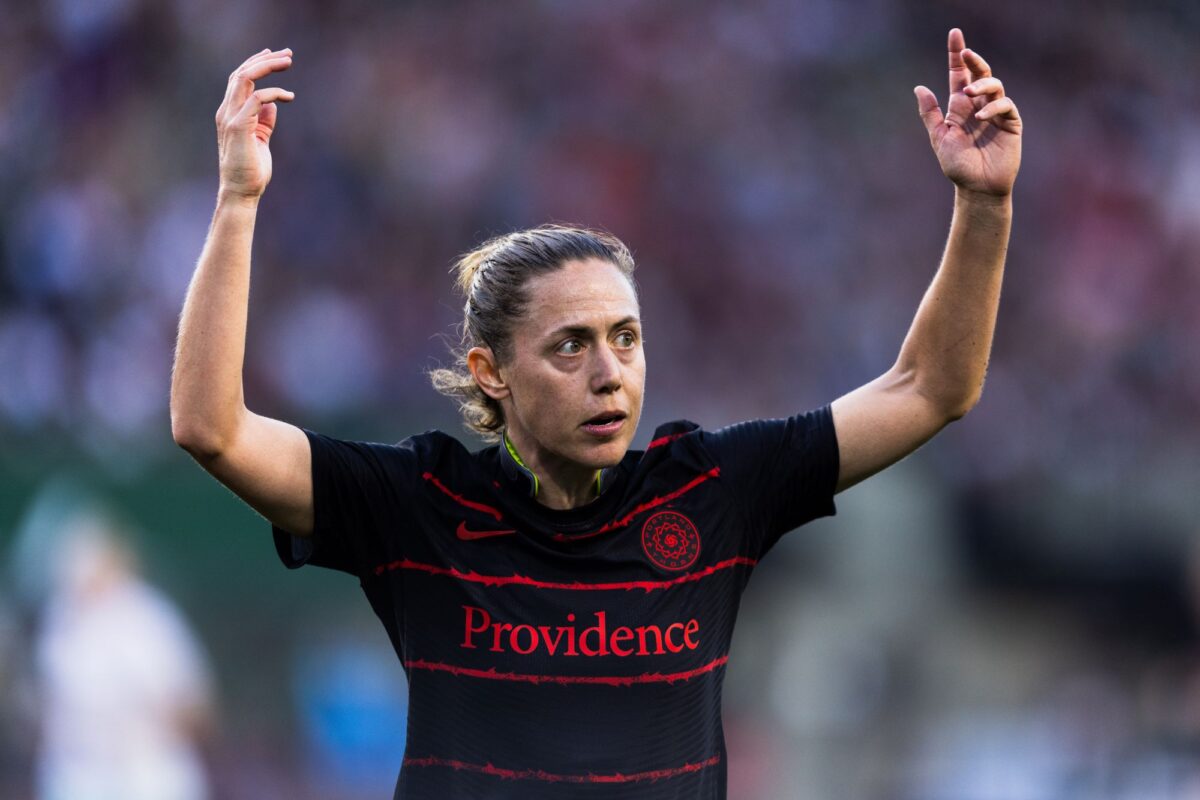
Down Sophia Smith and on the second match of a two-game road trip, the Portland Thorns took on Racing Louisville on Saturday. Portland has yet to take points from two back-to-back road games this season, and they weren’t able to break that streak in Kentucky; after leaving with a draw against the Washington Spirit the weekend before, the Thorns fell 2-1 to Racing in a match that didn’t feel like Portland’s best work—even without Smith.
So, where did the Thorns go wrong?
Set pieces, for one. They’ve been one of Portland’s weaker points all season, and Racing took advantage. Both of Louisville’s goals—an Abby Erceg header and a brilliant strike from Thembi Kgatlana—came off corner kicks.
But that wasn’t the only thing Portland struggled with.
“We’re probably our own worst enemy,” defender Meghan Klingenberg said after the game. “We gave the ball away in spots that we don’t usually give the ball away in, and that led to some counterattacks and transitions that were difficult to defend because we were in a big shape. I think that typically doesn’t happen to this team.”
Make no mistake: Racing was ready for this one. They came out with an aggressive press in midfield, showing organized marking and pressure when the Thorns had the ball and a commitment to pick off passes, go forward, and turn any chance they had into a shot.
“Credit to Louisville,” Thorns goalkeeper Bella Bixby said. “Their tactic was to be high-pressing and have all their numbers around the ball, and they did that well.”
The Thorns, for their part, were caught on the back foot and were rather lucky (more on that soon) to get out of those opening minutes without conceding a goal.
Perhaps just as impressive was Morgan Weaver, who won the ball off Louisville goalkeeper Katie Lund, took the ball to the left, and sent her shot into the back of the net in the sixth minute. It was a very Weaver goal: making something out of nothing, and—even if it wasn’t in the dying moments of a game—scoring for Portland at a time they really needed it. (In my game notes, I described the goal as, “Morgan Weaver doing Morgan Weaver things.”)
Even if Weaver scoring didn’t allow Portland to shift into the commanding attack we’re used to seeing them Thorns, it at least settled the game down and opened up chances for both sides.
As alluded to above, the Thorns were lucky to go into the half 1-0. Racing finished the match with 26 shots to Portland’s 15—a stat that normally favors the Thorns—putting nine of them on target to the Thorns’ four. They ended the game with 1.8 xG, with many of their best chances coming before Weaver’s goal in the first half:
xG Race Plot for @RacingLouFC v. @ThornsFC! #RacingLou #BAONPDX #LOUvPOR #NWSL pic.twitter.com/DvEPFDeET5
— Arielle Dror (@arielle_dror) September 3, 2023
That the Thorns didn’t concede early—and that Louisville wasn’t able to get on the scoresheet until Erceg broke through in the 60th minute—was largely due to two factors: luck and a stellar performance from Bixby.
In many of those opening chances, Racing struggled to direct their shots on frame, giving the Thorns a lucky break.
But Louisville did direct quite a few of those on target, calling on Bixby to make seven saves on the night. (Prior to Racing, she’d made an average of three and a half saves per game in regular season competition.)
“I definitely think it was one of my busier games in terms of goal-defending,” Bixby said. “I find myself in games, oftentimes, most busy with defending the box in terms of crosses.”
It wasn’t only that Bixby was busy in goal; even with the two goals against, she did well to defend her net. “A really big performance from her,” Portland head coach Mike Norris said. “She kept the [Thorns] in the game far longer than we probably should have been.”
Especially with a shaky—by her standards—middle of the 2023 season, it’s nice to see Bixby finding her form and giving Portland a fighting chance when they were on the back foot, even if they didn’t go on to win.
“They played a good game,” Klingenberg said of Louisville, “and I think their transition was pretty lethal. But I think we played right into it. We shot ourselves in our own foot.”
It’s not the first time Portland’s come up against that kind of pressure, Klingenberg said. And she’s right: the Thorns have had a target on their backs since the first time they stepped on the field as the reigning NWSL champions and beat the Orlando Pride 4-0 in their opener. And they’ve found ways to win despite that.
For some reason, though, Portland just wasn’t good enough in this one.
We can probably chalk some of it up to fatigue: the Thorns haven’t been home since before their matchup against the Spirit, and being on the road for that long can weigh on you.
“If we were more crisp, if we connected passes, if we skipped over top of their press, then we could have gotten past it,” Klingenberg said, and I think we can attribute at least some of that lack of sharpness to Portland’s road stint.
But I also wonder how much of it is up to tactics and the Thorns’ formation. As Jaiden wrote last week, it’s important for Norris to play to the strengths of the forwards he has available. In this case, that’s Weaver and Hannah Betfort. Weaver, obviously, got her goal, and Betfort got a couple chances off and showed well in her off-the-ball pressure, but I don’t think the Thorns were feeding the ball into either of them nearly enough.
I think some of that could’ve been helped by formation—maybe by pushing Olivia Moultrie more centrally into the space of Hina Sugita and asking Moultrie to open up space while Sugita takes on defenders on the wing.
I think a lot of that could’ve been helped by letting Crystal Dunn play before the 61st minute—maybe in the place of Moultrie and slipping Sugita into that wider position—and letting her open up space going forward. Even in her half hour on the field, Dunn tied Betfort and Weaver for first on the team in shots and was fourth in expected goals—despite playing significantly fewer minutes than everyone in front of her.
Tactics or tiredness, Portland has a chance to rest and regroup after this one. They have two weeks between Louisville and their next match against OL Reign, where they’ll take on a Seattle side that’s won only one of their last five matches but has a lot to play for with Megan Rapinoe appearing in her last Cascadia Rivalry game in Providence Park.
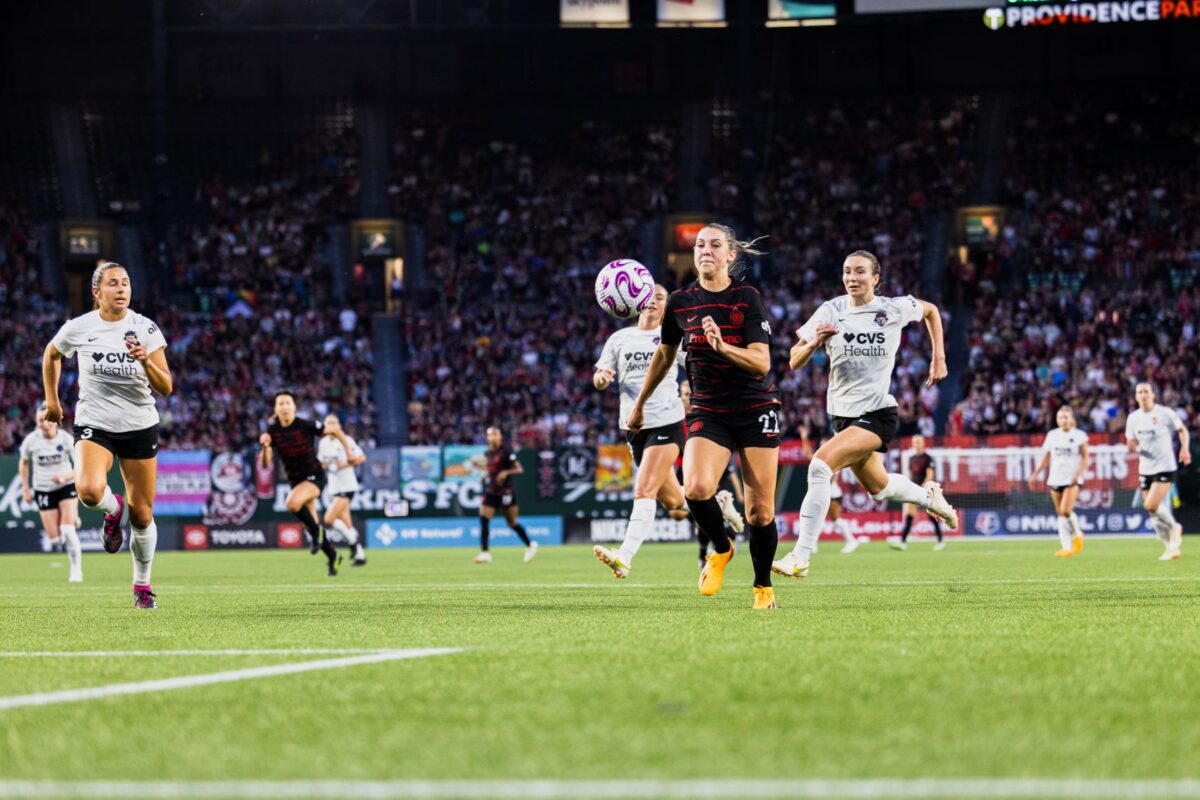
The Portland Thorns played their first game with all five World Cup players back in the squad last weekend against the Washington Spirit in DC. The team was coming off of a much-needed victory where the team set the record as the first NWSL team to receive a first-half red card (awarded to Kelli Hubly) and win the game. Better yet, that game resulted in the Thorns taking three points off the North Carolina Courage, which was probably the biggest win of a game that included some insane ball control from Hannah Betfort for the equalizer and a Sophia Smith game-winner less than a minute into her return to Providence Park.
With momentum on their side, the Thorns travelled to DC to take on Mark Parsons’ title-contending Spirit. More so than most teams in the league, both the Spirit and the Thorns had players that suffered significant World Cup roster-related injustices. Sam Coffey and Ashley Hatch were inexplicable snubs, Crystal Dunn had to play in a non-natural position, Sophia Smith and Trinity Rodman were wingers in a system that isolated them and didn’t let them perform to the best of their abilities— the list goes on. With squads filled with players who were looking to prove their talents after a lackluster USWNT performance, tensions were always going to be high, and the match was set to be cagey.
Ultimately, a 1-1 draw was not what the Thorns wanted after dominating 4-2 in the earlier matchup, and the game was less tactically promising than it could have been. Let’s look at why, and how it may affect the Thorns as they head into the final stretch of the season.
The Thorns debuted their new 4-4-2 formation against the Courage and brought it out again in DC. As someone who has advocated for more defensive coverage with such advanced wingbacks all season, I am delighted at the success of a Rocky Rodríguez-Coffey double pivot. It provides much-needed stability for Portland’s backline, which was especially necessary with the Meaghan Nally-Emily Menges backline that Portland started due to Hubly’s red card. The Thorns held the Spirit to 0.62 xG, not including the penalty—very low for a team that has the attacking powers of Rodman, Ashley Sanchez, and Ashley Hatch.
While the new formation allows the Thorns to more effectively carry the ball through the middle of the pitch and have adequate defensive coverage, there was a disconnect between the eight midfielders and defenders and the two forwards. The Thorns only had 10 total shots, four of which were on goal, a shockingly low number for the team who has scored an average of 2.3 goals per game this season. The Thorns also only had 78 passes within the final third for a 53% passing accuracy, matching the eye test that showed the midfielders unable to find the feet of Smith and Morgan Weaver. In fact, the players with the highest number of completed passes throughout the game were the four defenders and Coffey. While it is important to be able to maintain possession in your own half, you need to be able to progress the ball up the field in order to win a game. The Thorns were unable to consistently do that against the Spirit.
The new formation seems to have been created around Smith and Morgan Weaver, who have great chemistry and the ability to change sides and seamlessly float in behind the back line. However, when Smith went down with what we now know is a mild MCL sprain in the end of the first half and the scoreline was still 0-0, the pressure was on for head coach Mike Norris to make some kind of formation or tactical change in order to grind out the win.
Betfort has been coming in for Smith all season and started in Smith’s absence at the World Cup. However, Betfort’s playing style is immensely different to that of Smith’s. Honestly, there is no player in the world who plays at Smith’s level, and it is unfair of Norris to slot Betfort into Smith’s position and ask her to do the same things, like receiving the ball with her back to goal and dribbling through multiple defenders to get a shot off.
Betfort is an out-and-out No. 9. Her ball control has improved immensely over the course of the season, as has her shot selection. However, she does not have the same dribbling control that Smith has (to be fair, no other player in the world does). A 4-3-3 is much better suited to Betfort’s strengths, where she can receive the ball in the box and use her physical strength to shoot it on target. A 4-4-2 where Betfort is up front with Morgan leaves less room for her to get good services into the box, and it’s not fair to expect Betfort to produce in a way that is not playing to her strengths.
Additionally, Weaver traditionally has done very well at tight angles, when she is able to cut in from the left side as opposed to starting centrally. Transitioning back to a 4-3-3, where she and Hina Sugita play out wide up top, will allow both players to cut in and threaten goal—a tactic that has historically worked well for both players.
The Thorns only had seven crosses throughout the entire game, compared to Washington’s 14. I would argue that the Thorns’ only good chance of the night came on Weaver’s goal, and in large part was due to Coffey’s excellent weighted ball behind the backline. Betfort, who played over 45 minutes, only had 17 touches on the ball, meaning that she was essentially boxed out of the game—largely was due to the formation. Reyna Reyes, who played only 15 minutes, had more touches than Betfort. In Smith’s absence the Thorns need to go back to a formation that allows their available forwards to succeed.
Despite failing to block Hatch’s penalty kick in stoppage time, Bella Bixby had a very good game. She had four saves on the night, but her real strength during the game was organizing the defense and being aggressive in the box. This season Bixby has become more aggressive off her line, stepping out to get crosses and long balls to mitigate shots before they even happen. A lot of the play in the NWSL is direct and over-the-top, inviting players to go one-on-one with the keeper. By coming off her line early, Bixby forced the Spirit front line to try a different route to goal, which they struggled with. Meghan Klingenberg and Natalia Kuikka were largely able to shut down Washington’s forwards’ attempts at running down the wings, and if they were able to get a cross off, Bixby was quick to track it down instead of waiting for the second ball.
These abilities are ones that should be valued by the USWNT, so hopefully Bixby gets called into an upcoming camp, as her play this season deserves recognition.
Honestly, I think Hina was the player I missed most during the World Cup break. Her work rate and ability to stick with the ball is unmatched. I don’t know how she manages to win some of the tackles she does, and her trickery on the ball is so much fun to watch. With Smith likely out until at least the playoff run, I would argue that Hina will be the Thorns’ most important player during the next stretch of games. They will need to utilize her strengths to float around the pitch wherever she pleases. Hina Hive let’s get loud!!
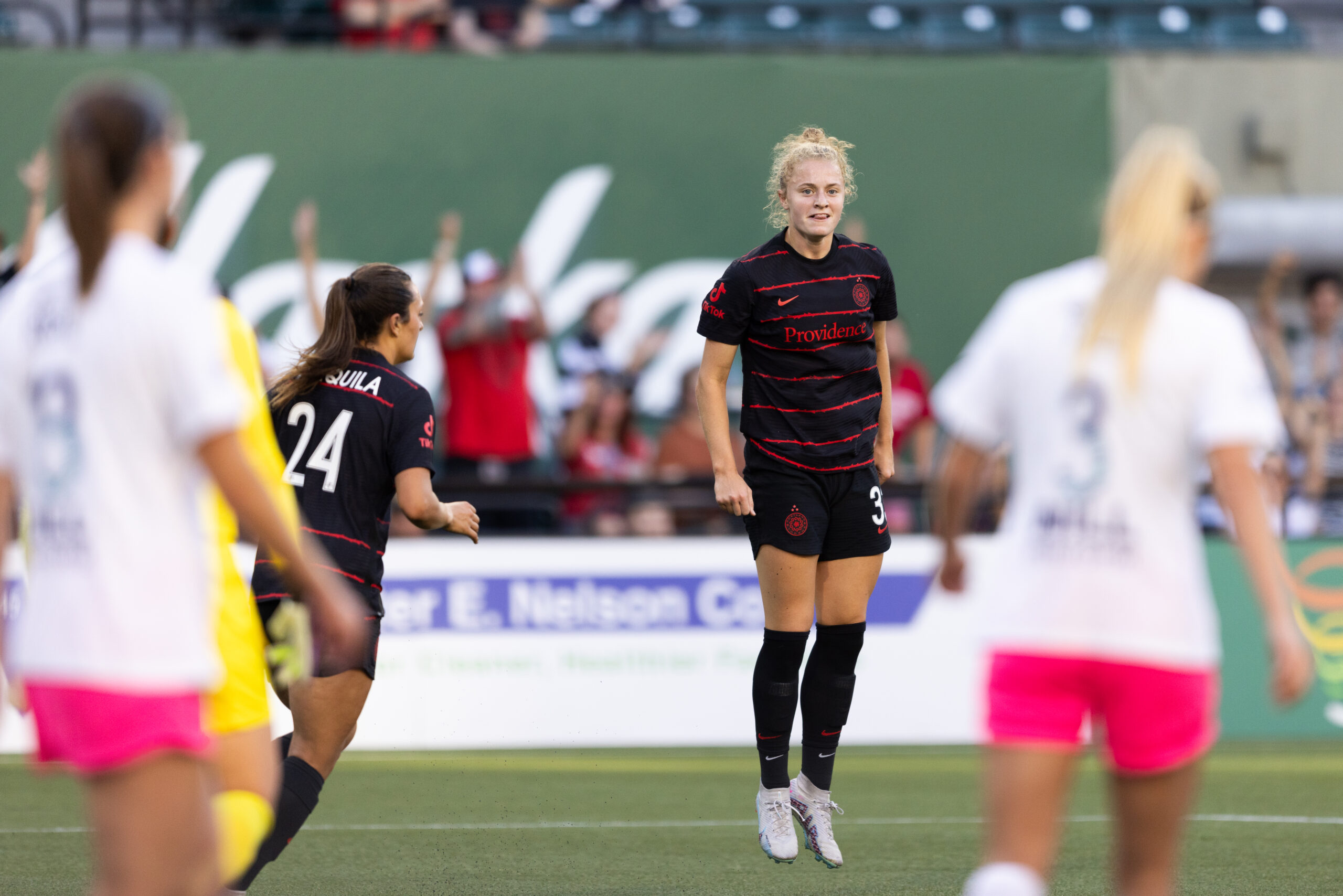
The Northwest Derby turned another chapter Sunday as the Portland Thorns—who were already eliminated from contention in the Challenge Cup—took on OL Reign up in the Emerald City. It was a battle of defenses, resulting in a 0-0 draw that left Thorns fans breathing a sigh of relief.
Heading into the match, it would be understandable to expect head coach Mike Norris to throw in the towel on a match like this, rest all starters, and just get some minutes for the deeper bench. It would also be understandable for someone to look at the schedule and Portland’s recent results and say, “This is a team desperate for a win; we need to start whoever is available.”
In the end, the Thorns split the difference, starting Shelby Hogan and Izzy D’Aquila in place of Bella Bixby and Morgan Weaver. A veteran-heavy backline left Reyna Reyes, who’s shown significant growth in form this season watching from the sidelines, as Meaghan Nally came in as a defensive sub for Emily Menges late in the second half.
Watching this match as a fan of the team would not have been easy, I will concede that.
Fortunately, I was able to don my “media” cap for this one and set my emotions aside as I watched OL Reign dominate on the attacking action on pitch. The Thorns struggled to get into the attacking third in the first half, as their passes continued to get picked off through the midfield. Without Weaver in the starting lineup, the team lacked the burst-speed to get behind the backline and play over the top, as well. With the exception of a few half-chances, the Thorns never looked particularly dangerous offensively in this match, and with Weaver only seeing roughly 15 minutes, including stoppage, the chances just never materialized. Fortunately, the Thorns defense and Hogan played a solid match, keeping the score 0-0 and giving Hogan a well-deserved shutout. Given Challenge Cup stakes for either team, to escape Seattle with a point is a victory for Portland and a disappointment for OL. That is always something Riveters can hang their hat on.
All-in-all, I got the message: We want to be competitive, but we want to get our depth players some minutes before the international players return as well. Players need match minutes to develop.
I recognize that many may disagree. Players come to play, and they always (or should always) give 100%. I won’t ever imply that players take games off, but sports psychology is a finicky field. Playing in front of a crowd, the adrenaline of competing against another team, and the ability to match the intensity, skill, and focus of an experienced opponent whose goal is to pulverize you, is not easily replicated in practice. Additionally, some teams perform better when their backs are against a wall; must-win games can bring out another level in a team and their players. But why does this matter though when we are getting several of our international stars back within the next couple weeks? (Editor’s note: I’m still mad that Japan isn’t advancing past the quarterfinals, but it’s nice that all our World Cup players should be on their way back to Portland in the near future.)
It is hard for me to criticize USWNT head coach Vlatko Andonovski for his lack of rotation of the during World Cup, only to turn around and also criticize Norris for giving minutes to rotational players instead of regular starters—especially in a Challenge Cup match that wouldn’t realistically change our standings in either the league or the Challenge Cup race.
That doesn’t mean this was a meaningless match. You always want to field a competitive team, especially in a derby, if for nothing else than for team psyche and routine. However, the chance for players like D’Aquila and Taylor Porter to get extended minutes is an opportunity the Thorns hope will pay dividends in late September and early October. With the Challenge Cup now a mid-season tournament, players are playing far more minutes each week than they are accustomed to. International players have had to add their duties to their country, and the resulting additional travel, on top of these extra games when they are with their club. It’s a lot of minutes on the body.
As the season winds down, teams are looking to make a push for playoff positioning. The intensity is going to rise, and the minutes will be harder and more physical, players’ bodies are going to take longer to recover, and the fear of injuries will intensify. As the season goes on, having these rotational players ready to plug in will be extremely important. Developing their game mentality and their physical abilities to compete at the NWSL level will be a risk that should see benefits throughout the remainder of this season—and hopefully into the playoffs.
It is a unique perspective to watch a match from the press box, one you don’t get on camera or from the stands. As I watched OL continue to drop ball after ball over the Thorns’ outside backs, as Kelli Hubly and Menges did their best to rotate and take away angles, I realized how much the midfield still needs tweaking on the defensive end.
Having attacking outside backs like Meghan Klingenberg and Natalia Kuikka leaves the defense in a constant state of transition. It felt, for much of this match, that the midfield needed to support the backline by getting back defensively. Too many times the Regin’s counterattack left the Thorns scrambling.
This didn’t seem like a practical skill issue as much as a situational awareness issue.
Players appeared to be clambering to put out fires they hadn’t anticipated.
The Thorns have a midfield of players who excel at maintaining possession with the ball at their feet, but outside of Sam Coffey, it seemed the Reign defense was too often picking off the ball, resulting in Seattle counterattacks. When that happened, it became a mad dash to stop the bleeding. And fortunately, the Thorns had the skill and physical attributes to do so.
Going back to my previous takeaway, this is something that can be practiced in training, but is a skill that takes match minutes to really become proficient at. It’s a mental preparation of visualizing possible outcomes, including the movement of opposing players positioned around the pitch, and how to respond. Veteran players have experienced nearly every outcome, have learned from their mistakes, and tend to be able to react with lower levels of stress and put themselves in less vulnerable positions. This is one reason why getting those minutes to rotational players in matches like this, will be better for the team down the road.
That said, practicing visualization outside of matches will have practical applications for mental preparedness during in-match scenarios. Similar mental preparation tactics are deployed across occupations that face high-stress and volatile situations, such as emergency responders. In the moment, our brains don’t recognize the difference between, “Oh no, this is a life threatening situation,” and, “Oh no, I made a mistake that may give up a goal.” We all lack the ability to differentiate the value of those when our brains kick in the cortisol, but mental preparation helps us preemptively adjust in relation to changing conditions such as defensive positioning.
With outside defenders moving so far up the pitch into the attack, the midfield needs to prepare themselves better mentally to react on the defensive end.
In case anyone was wondering, Sophia Smith, Hina Sugita, Weaver, Rocky Rodríguez, and Crystal Dunn are really, really fast. Their presence has the ability to change the offensive look of this team. The Thorns struggled to drive the offense past the Reign’s defensive midfield through the feet of Coffey. Hannah Betfort is a fast player, and can outrun much of the team in a baseline-to-baseline sprint, but the aforementioned players would win handily in a sprint from baseline to the top of the keeper box. Tziarra King had this for OL, which is another reason they were able to play over the top so easily against Portland. Without that quick burst of speed, the Thorns lacked the ability to play over the top, and struggled to get footholds offensively. OL Reign were able to dedicate their defensive resources to keeping play near the centerline of the pitch and to disrupting passing lanes.
None of this is an indictment of the talent or skill of Betfort or D’Aquila. The Thorns don’t lack for talent, but the talent needs to be complimentary within the system, and the system didn’t adjust to fit Betfort and D’Aquilla. They’re just currently not the type of forwards who create the extra foot of separation needed to put a defense on their heels and cause chaos for an opponent’s backline, like Smith and Weaver are.
There are ways for them to develop positioning tactics, like we’ve seen from Christine Sinclair or Lindsey Horan, that would make them more effective and impactful in the roles they play.
But the main takeaway is that without the dual speed of Smith and Weaver, or Weaver and Hina Sugita, the Thorns just aren’t getting behind enemy lines and become largely one-dimensional offensively. This has become glaringly obvious in the team’s recent run of play. Hopefully, the change of roles for D’Aquila and Betfort upon the return of Portland’s World Cup players allows them to be more effective within their minutes—and allows the team to be more effective at supporting their skill sets.
The World Cup misfortunes of Canada, Costa Rica, USWNT, and now Japan will hopefully breathe life back into a stagnant Thorns offense in the coming weeks. With the return of Rodríguez, Smith, and Dunn, the Thorns will get injections of speed and energy (not to mention the reigning NWSL MVP, who is statistically on pace to be in contention to repeat the title). One of my favorite aspects of Sinclair this year has been her defensive tenacity on turnovers between the goal and centerline, often getting the ball back before it can be played forward, if not disrupting the play and slowing the counter. The Thorns still sit comfortably in second place in the NWSL standings, with a majority of the NWSL matches during the World Cup being of the Challenge Cup variety, and not impacting league standings.
They return home on Sunday, Aug. 20 for a match against the North Carolina Courage. Whether or not international players will be available for that match remains to be released, but an eventual return is inevitable, and tentatively on the horizon for some. In the meantime, the Thorns will continue to watch the film and grow from these opportunities.
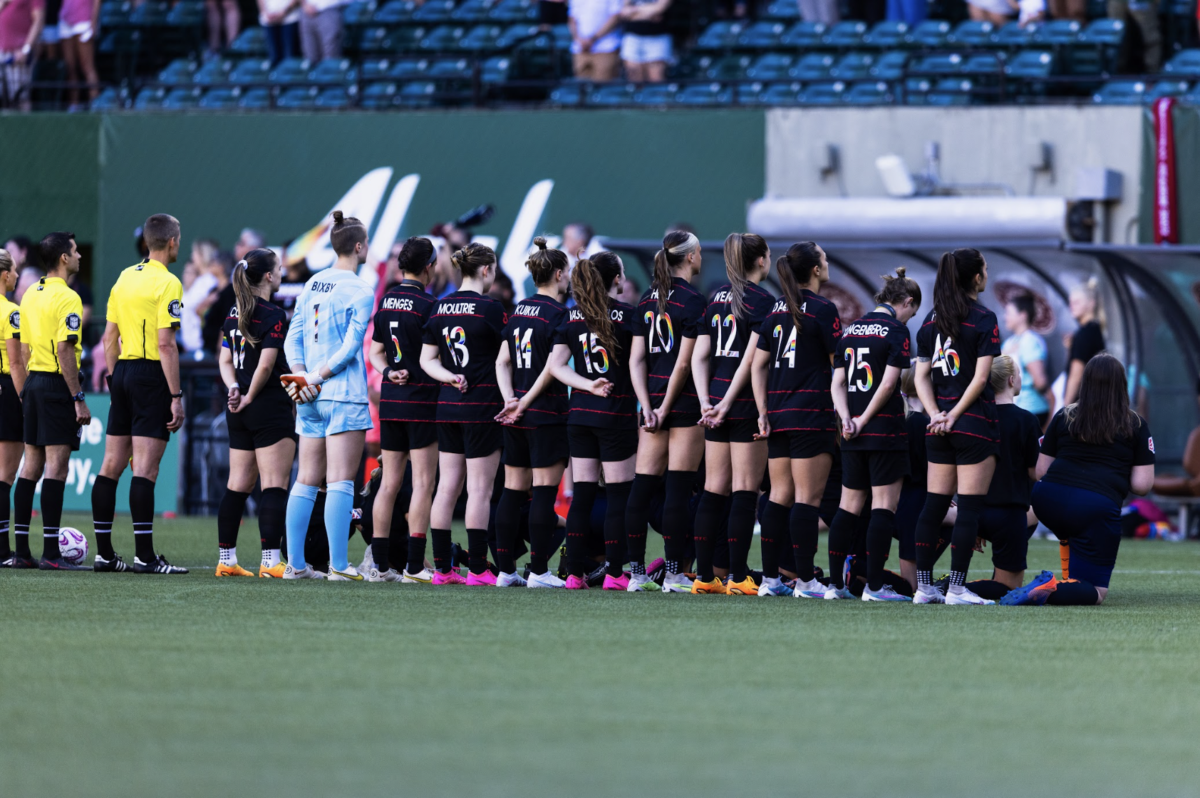
The Portland Thorns have officially wished their international players well in the FIFA Women’s World Cup and are embarking on the next portion of the season without their most prolific attacking threats. Portland will play six games before the international players are slated to come back at the end of August: three for the regular season and three for the Challenge Cup.
This week, we got our first glimpse at what the Thorns will be like during this next stretch of games. Without Sophia Smith, Crystal Dunn, and Hina Sugita up front, it was underwhelming to say the least.
The refereeing in both games was questionable at best and atrocious at worst, but regardless of what the officials are doing, it is the players’ job to put the ball in the back of the net.
After the sensational send off game versus the Spirit—a top of the table clash that resulted in a 4-2 Portland victory—the Thorns had a pair of disappointing 0-1 losses at home.
What happened? It is a mix of available personnel and coaching decisions that can no longer be hidden behind the individual brilliance of Sophia Smith.
Of the healthy and available players in Portland, three are goalkeepers, eight are defenders, four are midfielders, and five are forwards. Since the NWSL trade window has opened, the Thorns have only made one official signing, bringing center back Kayla Morrison into the team as a national team replacement player and adding depth to probably the only position that already had it. Morrison will join Kelli Hubly, Meaghan Nally, Emily Menges, and Gabby Provenzano—alongside Natalia Kuikka, who has slid into the position several times this season.
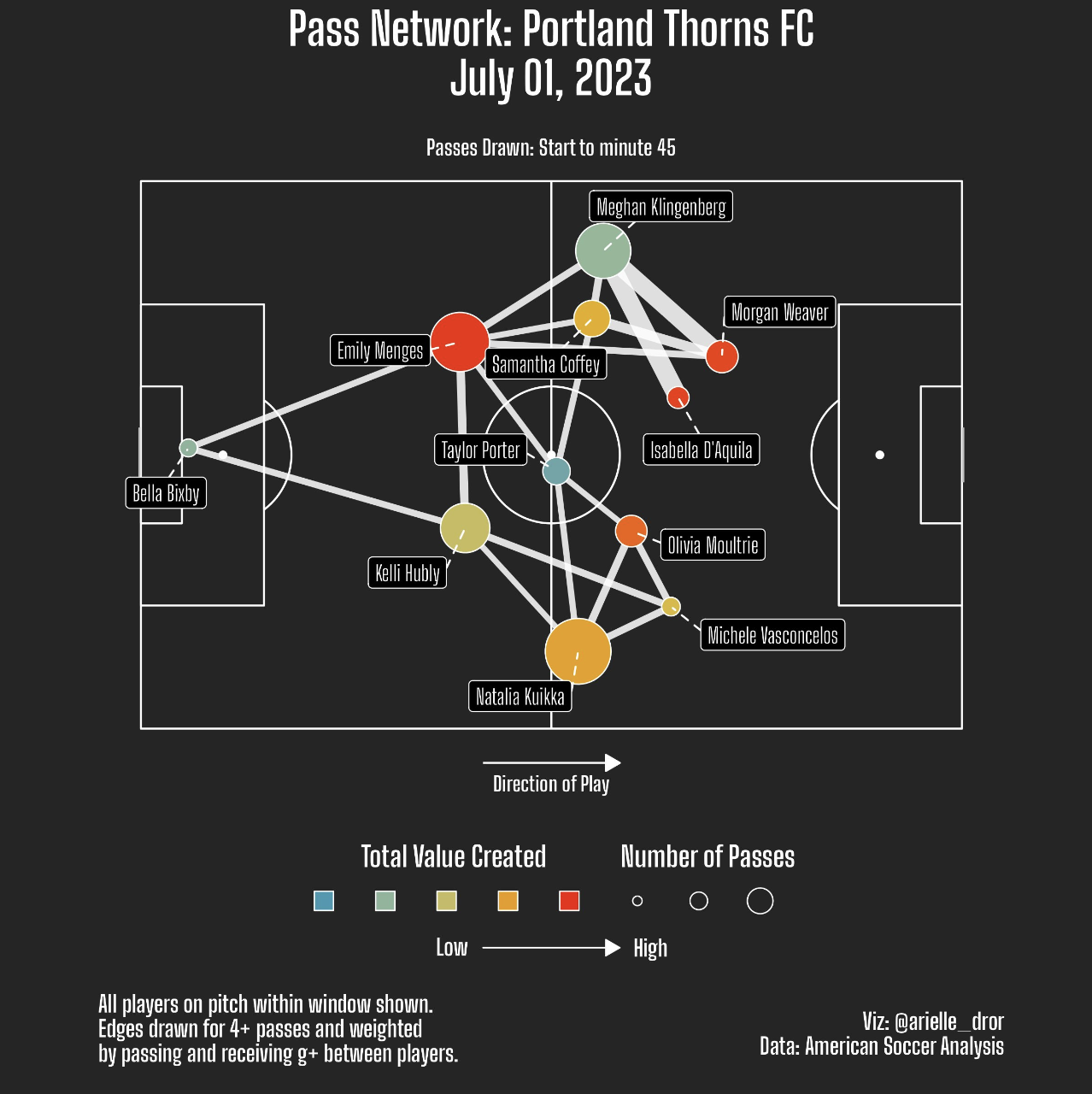
Against the Current, the Thorns lined up in their usual 4-3-3, with the most notable change being that Sam Coffey was able to play higher up the pitch and was given the freedom to carry the ball forward. Meghan Klingenberg and Kuikka, as the fullbacks, were asked to play incredibly high up the pitch, leaving Menges and Hubly exposed as a flat 2-back pairing. By this point in the season, it seems clear that head coach Mike Norris’ game plan is to try and instigate attacking momentum through his outside backs, as Kling and Kuikka had 40 and 47 carries, respectively. When this number is compared to midfielders Taylor Porter’s and Coffey’s carries of 18 and 28, respectively, it shows the Thorns’ lack of meaningful possession in the midfield.
When Smith is waiting up top, playing through the wings to try and send her on a one-versus-one breakaway isn’t that bad of an idea, but without her dribbling skills up top, the Thorns did not look dangerous coming out of the wide areas. Subbing Reyna Reyes on for Michelle Vasconcelos at the half to bring a more defensive-minded winger onto the pitch did not change the way in which the Thorns attacked, as Reyes did not cut inside or play as fluidly along the front line as the Thorns typically do. Granted, it was Reyes’ second time playing up top for the Thorns, and she has been having a terrific rookie season, but nonetheless her appearance did not mark a change of tactics in order to try and earn a win in the second half.
Once the Thorns were able to bring the ball into the attacking third, poor shot selection was their downfall. Portland, always a team that is able to wrack up a lot of shots over 90 minutes, had 26 against the Current, with nine on target.
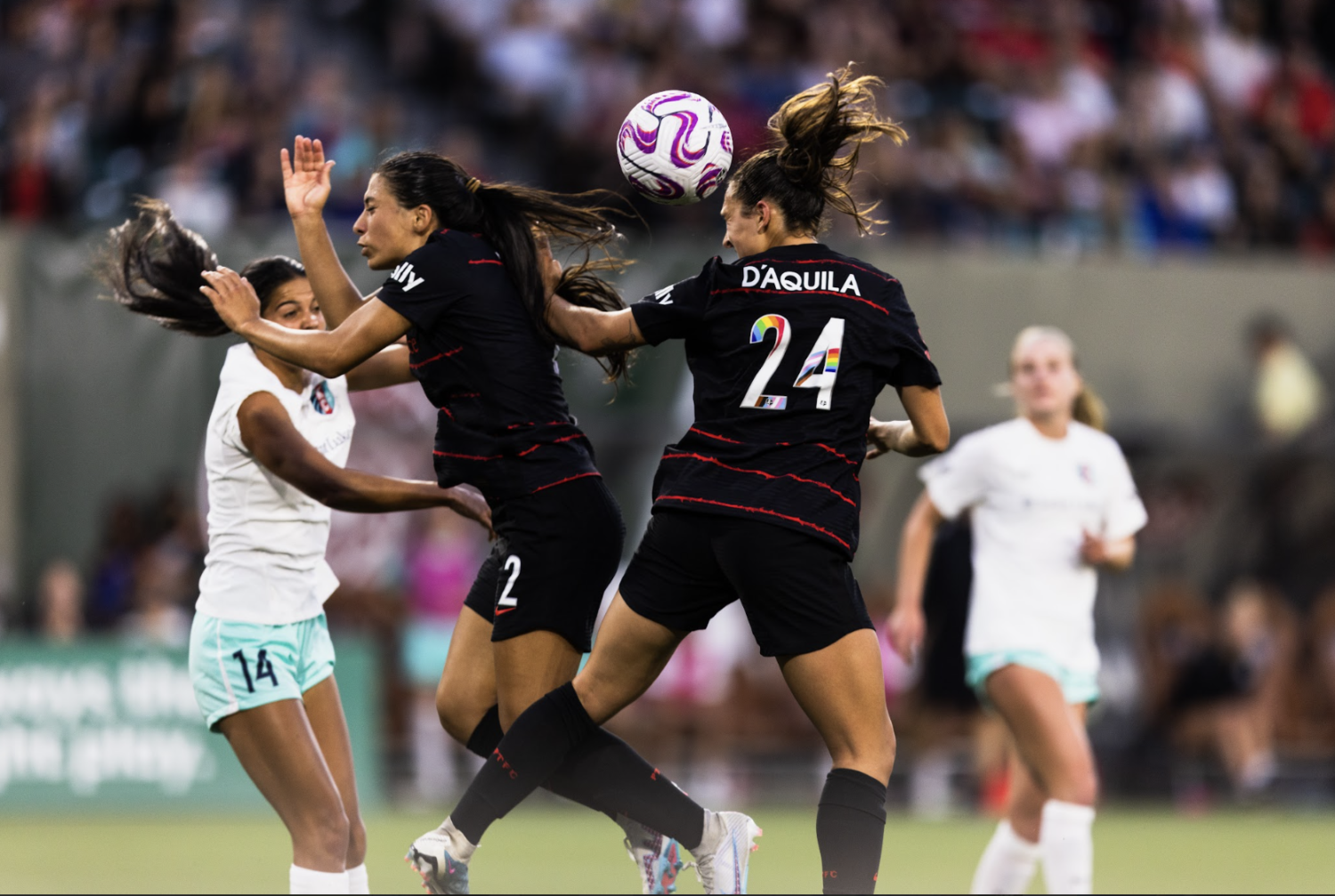
Only Izzy D’Aquila and Morgan Weaver had more than 10 touches inside the Current’s penalty area throughout the game, with 12 and 13, respectively. The next highest player, Olivia Moultrie, had only six.
In previous games the Thorns have been incredibly successful inside their opponents’ box at playing dummy balls and creating space for easy tap-in goals, but over the past two games we have not seen this type of play. What we have seen, however, is players taking shots early instead of taking extra touches to get themselves around a defender or to fin a better angle. If you had to take a shot (pun intended) for every time the Thorns players gifted the ball directly to Kansas City goalkeeper Cassie Miller without challenging her to make a save, you would have had a much better time at the game.
So, what is the reason for this flat, uninspired play the Thorns have shown in both their midweek game against the Reign and the weekend’s one against the Current? While it may be a multitude of reasons, the most glaring one is the lack of changing tactics either mid-game, when the current plan isn’t working, or around the available personnel and their strengths.
For example, the Thorns’ xG in the first half against the Current was 0.75, while the second half was 0.85. The marginal difference between the two numbers is negligible, indicating that there was no real change or improvement in the attack between the two halves. Another example was the 70th-minute sub of Hannah Betfort for Porter, which shuffled D’Aquila to the wing and Kling into the midfield. D’Aquila, a prolific striker for Santa Clara, was incredibly effective with her head. Even though the Thorns had not been able to take advantage of this asset for the previous 70 minutes, they chose to bring on a player whose main advantage is her height in aerial duels. Betfort ended up not having a shot that evening.
When playing from the outside in wasn’t working, the Thorns should have tried to carry the ball through Coffey in the middle. Coffey only had 94 yards worth of progressive carries over 90 minutes, much fewer than Kuikka and Kling, who both had over 200. Coffey, playing the attacking mid position she excelled at in college, was far and away the best player on the field. Her confidence while wearing the captain’s armband was high, and she was able to float around the opposing team with ease, completing 76% of her passes. The Thorns are incredibly lucky to still have Coffey during this World Cup period, and it is in their best interest to make her the primary playmaker during this time.
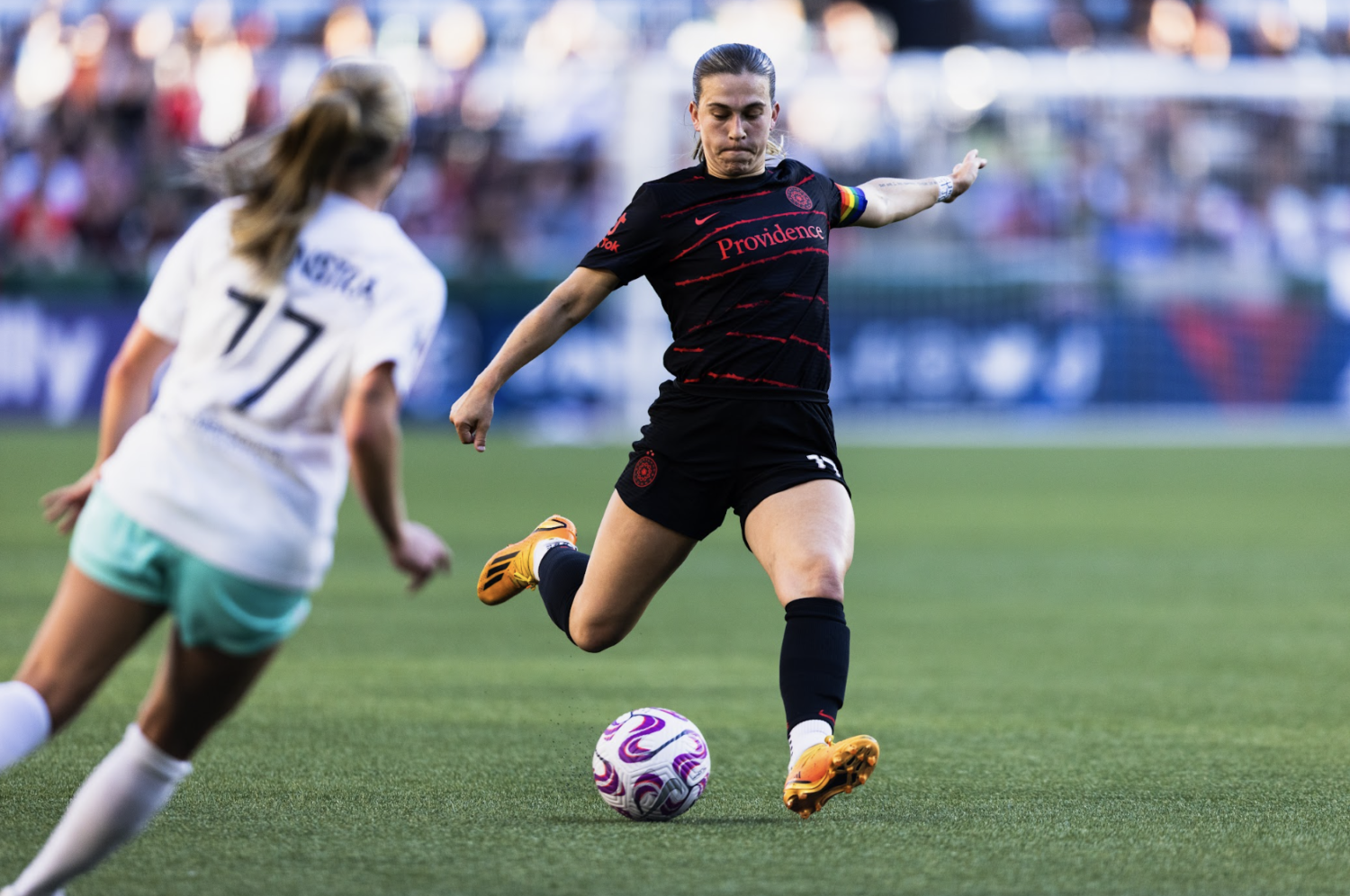
Hopefully the Thorns will have signed a few more national team replacement players—Norris hinted at at least one more signing on Saturday—to bolster their sparse frontline before they go again next weekend against Gotham in New York.
